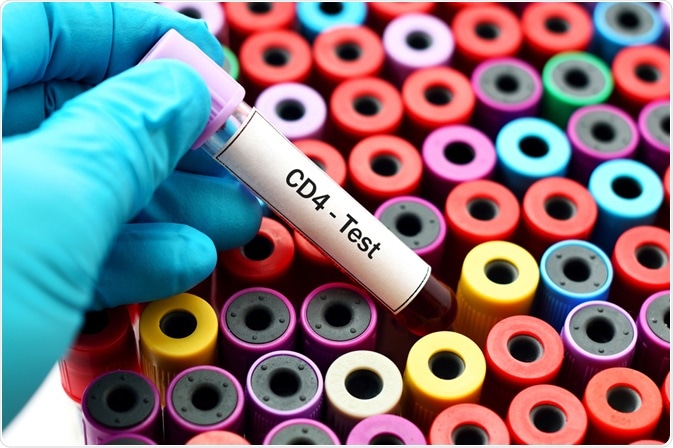
A cluster of differentiation (CD) is a single or group of molecules on the surface of a cell that is highly specific to that cell, allowing one to identify it amongst others.
 Image Credit: Jarun Ontakrai / Shutterstock.com
Image Credit: Jarun Ontakrai / Shutterstock.com
The molecules often act as ligands or receptors, though may also have some unrelated function such as cell adhesion, and may consist of a mixture of proteins, glycoproteins, and glycolipids. Some are trans-membrane, while others are entirely extracellular.
CD markers often refer specifically to leukocyte cell surface molecules, as the system was developed in 1982 at the 1st International Workshop and Conference on Human Leukocyte Differentiation Antigens to deal with the growing number of monoclonal antibodies generated against the many epitopes of leukocyte antigens. However, it has since been expanded to include many other types of cell.
CD nomenclature
CD markers are labeled by numbers, for example, CD3 is a protein complex specific to T lymphocytes, with the antigen appearing on the cell membrane of all mature cells. “CD3” refers to the antigen, while the “CD3 antibody” is the monoclonal antibody that interacts with it, of which there may be more than one.
Additional letter designations may be assigned to the CD, such as a lowercase “w” before the number to indicate a tentative assignment or a CD with only one known antibody. Spliced CD variants are indicated with an uppercase letter following the numbers, while lowercase letters indicate regions of larger molecules that share a common chain. For example, integrin is a membrane protein composed of two chains that bear multiple clusters of differentiation, CD11a to CD11c.
CD identification
Cells can be immunophenotyped by their CD molecules using fluorescence microscopy. Attaching a fluorophore to the CD antibody allows a researcher to label each cell with a distinctly colored fluorescent dye or protein, binding to the cell surface via the target CD antigen.
A number of analyses can subsequently be performed on the tagged cells, one of the most useful of which is flow cytometry. Flow cytometry is a sensitive high-throughput method of analyzing the cells of a heterogeneous tissue sample, passing each cell over a series of lasers and detectors that excite the fluorophores and subsequently detect the emitted photons.
The high-throughput nature of flow cytometry allows a large statistical data set to be obtained, letting researchers create algorithms to organize and arrange the newly discovered CD antibodies in cases of target identification and CD antibody generation.
Clinical uses of CD markers
CD markers are useful in both the diagnosis and treatment of a number of diseases. The presence of a large number of one particular type of lymphocyte, identified by high-throughput flow cytometry of a biopsy sample, may indicate that the patient is suffering from one specific problem over another. For example, CD3, present on all T-lymphocytes is a useful immunohistochemical marker to identify tissue inflammation and can help diagnosticians to distinguish between B-cell and T-cell leukemia.
The high specificity of monoclonal antibodies have made them indispensable in the diagnostic field, but have been limited as drug targeting ligands due to the potential for the antigen to be presented elsewhere in the body, and the possibility of difficult to predict downstream effects such as the generation of cytokines by activated immune cells and their aggregation in the serum.
This can lead to immunogenicity issues as the body tries to remove the foreign protein aggregates. However, the field is rapidly evolving and many of these safety concerns have been overcome in recent years, with monoclonal antibody-based medicines being increasingly employed clinically for the treatment of cancers, inflammation, and autoimmune diseases.
Animal testing is also undertaken to test the potential effect on the human immune system of exposure to toxic substances, made possible by the distinctive CD markers of each type of immune cell. Following exposure to the substance, a differential count of the lymphocytes is indicative of toxicity.
Sources
Jahan-Tigh, R. R. et al. (2012) Flow Cytometry. Journal of Investigative Dermatology, 132.
https://core.ac.uk/download/pdf/82716365.pdf
Zola, H. & Swart, B. (2005) CD Markers. Encyclopedic Reference of Immunotoxicology.
link.springer.com/referenceworkentry/10.1007%2F3-540-27806-0_216
Engel, P. et al. (2015) CD Nomenclature 2015: Human Leukocyte Differentiation Antigen Workshops as a Driving Force in Immunology. The Journal of Immunology, 195(10).
https://www.jimmunol.org/content/195/10/4555
National Research Council (US) Subcommittee on Immunotoxicology (1992) Biologic Markers in Immunotoxicology.
https://www.ncbi.nlm.nih.gov/books/NBK235679/
Awwad, S. & Angkawinitwong, U. (2018) Overview of Antibody Drug Delivery. Pharmaceutics, 10(3).
https://www.ncbi.nlm.nih.gov/pmc/articles/PMC6161251/
www.sinobiological.com/research/cd-antigens/cluster-of-differentiation
Further Reading
- All Flow Cytometry Content
- Flow Cytometry Methodology, Uses, and Data Analysis
- Flow Cytometry Techniques used in Medicine and Research
- Flow Cytometry History
- Fluorescence-Activated Cell Sorting
Last Updated: Jan 15, 2021

Written by
Michael Greenwood
Michael graduated from Manchester Metropolitan University with a B.Sc. in Chemistry in 2014, where he majored in organic, inorganic, physical and analytical chemistry. He is currently completing a Ph.D. on the design and production of gold nanoparticles able to act as multimodal anticancer agents, being both drug delivery platforms and radiation dose enhancers.
Source: Read Full Article